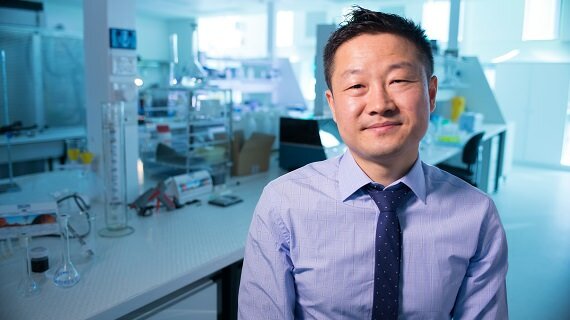Last updated October 23, 2017 at 10:39 am
Professor Dayong Jin is the recipient of the 2017 Malcolm McIntosh Prize for Physical Scientist of the Year for his work in creating new kinds of microscopes that enable scientists to study molecules at work inside living cells. He was recognised among other winners at the Prime Minister’s Prizes for Science event.
Dayong is an early career researcher leading the way in creating technology to help detect and prevent disease. There is a need for new ways to detect the early stages of disease and cancer to allow for medicine to save lives. Dayong believes the key is for physicists, biologists, engineers and doctors to work together.
 Dayong brings perspective and knowledge of a physicist to the challenges of cutting-edge biology. He believes that the biological sciences currently do not have the tools they need to study and understand the processes of life at work. And until we have that understanding we will struggle to develop fast, effective and economical ways to monitor our health and treat issues before they become critical.
Dayong brings perspective and knowledge of a physicist to the challenges of cutting-edge biology. He believes that the biological sciences currently do not have the tools they need to study and understand the processes of life at work. And until we have that understanding we will struggle to develop fast, effective and economical ways to monitor our health and treat issues before they become critical.
“Biologists want to be able to watch and follow individual molecules in living cells. Then they could see exactly what’s happening step by step,” Dayong says. “And clinicians need to find a needle in a haystack – one infected or cancerous cell amongst millions of health cells.”
Several major obstacles stood in the way of Dayong and other scientists of creating microscopes that can follow live molecules and find that proverbial needle in a haystack.
Currently, conventional microscopes are limited to half the wavelength of light by the laws of physics, which is around 0.2 micrometres or over 250 times smaller than the width of a single human hair. The winners of the 2014 Nobel Prize for Chemistry broke through that limit with the help of fluorescent molecules, which led to laser-driven ‘nanoscopes’ being developed and used by scientists.
However, these super-resolution nanoscopes are too hot to image living samples, with the heat of the fluorescent molecules damaging living cells. Additionally, they are too expensive to be developed into low-cost diagnostic devices that could be widely manufactured and used across the globe.
Starting at Macquarie University and now at the University of Technology Sydney, Dayong and his coss-disciplinary team created a series of patented photonic technology microscopes. His new microscopes use quantum dots, lasers, nanocrystals and other technologies to see things smaller than the microscopic scale. They let scientists watch the inner workings of our immune system, witness the evolving of bacteria to become resistant to antibiotics and find one cancer cell among millions of healthy cells.
He is currently working with Olympus, the same company that produces digital cameras, to commercialise his invention and make it available for other researchers to use. He compares the change to the transformation of navigation.
“It’s much easier to drive with GPS and a smartphone map, than with traditional paper maps. And you can drop into street view and see the details. Biologists are still working with ‘paper maps’,” he says.
But his personal vision goes much further.
He believes that his technologies will enable portable, easy-to-use devices to detect the first signs of disease, evidence of drugs, or of toxins in food and the environment. With the support of the Australian Research Council he’s working to give Australian companies the opportunity to create these new devices.
Now Dayong also leads an industry research hub which he hopes will enable Australian companies to commercialise these new technologies. His technologies will have much wider application across diagnosis, invisible anti-counterfeiting inks, and even an optical safety system for motorcyclists.
RELATED VIDEO: 2017 Prime Minister’s Prizes for Science Part 1
Image credit: Prime Minister’s Prizes for Science/WildBear
Australia’s Science Channel is proud to be a media partner for the Prime Minister’s Prizes for Science 2017.
Follow us on Facebook, Twitter and Instagram to get all the latest science.
































































































































































































































































